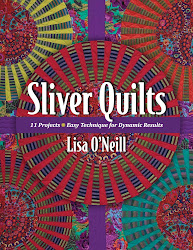 For today I thought I'd stick with the basics, addressing three variables - dry application, wet application and a thickened application. Last night I played with applying the ink straight from the bottle - dry brush onto dry fabric and I was quite pleased with the results. What might happen if I wet the fabric??? Below you can see the comparison of dry (top) to wet (bottom) application - quite significant.
For today I thought I'd stick with the basics, addressing three variables - dry application, wet application and a thickened application. Last night I played with applying the ink straight from the bottle - dry brush onto dry fabric and I was quite pleased with the results. What might happen if I wet the fabric??? Below you can see the comparison of dry (top) to wet (bottom) application - quite significant. 
First dry on dry - dry brush onto dry fabric. The sample has been allowed to dry completely. The dot to the left of the color stripe is wet to allow for a color saturation comparison of wet to dry. I applied a thick strip using a fresh 3/4 inch brush for each color. Aside of the thick stripe I used the tip of the brush to apply a thin line. As you can see there is very little bleeding of the color in the blue and the umber, however, the red does show a slight bleed. The saturation value of the color changes little for the blue and umber, but there is a noticeable loss of saturation in the crimson. The coverage with the umber was not as complete.

This is the sample of wet application (it has been allowed to dry). I applied the ink to the wet (drenched, then wrung out completely) fabric as described above. Again, the dot to the left of the streak is a fresh application of wet ink to see the comparison in color wet to dry. As you can see there is a great deal of bleed, particularly of the red ink. There is actually so much bleed that the thinner stripe of ink has blended into the larger stripe of both the blue and crimson. There is also a significant loss in saturation of the color. The blue, and particularly the umber, exhibit a ringing effect at the edge of the color.

Next I wanted to thicken the ink. I couldn't find my Liquitex Gel Medium so I used Liquitex Acrylic Gesso to thicken the ink. I have since found my Liquitex Acrylic medium and will post on that at a later date.
 The gesso is definitely going to effect the color.
The gesso is definitely going to effect the color.  I used a palate knife to blend the ink into the gesso, stopping initially when I achieved an interesting incomplete blend.
I used a palate knife to blend the ink into the gesso, stopping initially when I achieved an interesting incomplete blend.  I applied the incomplete blend using a palate knife to one side of my fabric sample. I then completely blended the gesso to a uniform color and applied it to the other side of the fabric.
I applied the incomplete blend using a palate knife to one side of my fabric sample. I then completely blended the gesso to a uniform color and applied it to the other side of the fabric.  Here is the result of the three different colors. From top down - the incomplete blend, in the center a sample of ink directly from the bottle without gesso allowed to dry, and on the bottom the complete blending of the ink into the gesso. The small dot of ink to the left of each sample is wet for color comparison purposes. There is a significant loss of saturation with the addition of the gesso. I love the mottled appearance of the incomplete mix and can see many applications for it. There is also a significant change in the hand of the fabric - the gesso has made it stiff and rough.
Here is the result of the three different colors. From top down - the incomplete blend, in the center a sample of ink directly from the bottle without gesso allowed to dry, and on the bottom the complete blending of the ink into the gesso. The small dot of ink to the left of each sample is wet for color comparison purposes. There is a significant loss of saturation with the addition of the gesso. I love the mottled appearance of the incomplete mix and can see many applications for it. There is also a significant change in the hand of the fabric - the gesso has made it stiff and rough.
While I had some ink thickened I thought why not play with silk screening. I used an old Print Gocco screen with wording on it for the test - this screen never printed well - the lettering was too small.
 I also tried it using one of my big screens with a very simple design.
I also tried it using one of my big screens with a very simple design. Here is the result of the Print Gocco trial - this is pretty good considering the poor quality of this screen.
Here is the result of the Print Gocco trial - this is pretty good considering the poor quality of this screen. It also worked very well with the other screen I used.
It also worked very well with the other screen I used.  I have many more samples to share with you over then next week. While all of this experimenting is fun I need to come up with my project idea for the C&T Publishing's Creative Troupe- I'm honing in on an idea and am getting pretty excited about it. Can't share that just yet.
I have many more samples to share with you over then next week. While all of this experimenting is fun I need to come up with my project idea for the C&T Publishing's Creative Troupe- I'm honing in on an idea and am getting pretty excited about it. Can't share that just yet.



















2 comments:
like the effects with the gesso...good tutorial thanks
Hi! i found your blog while searching google for Liquitex Ink. There's a little serendipity at play because today my own Liquitex Inks arrived on my doorstep. i've also been experimenting a little, but you've covered much more ground than me. It was great to see how the ink is affected by different mediums. Thanks for sharing your results!
Post a Comment